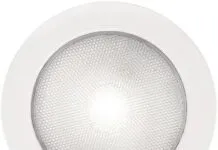Deck, Hull-to-deck Joint, and Keel Merit a Close Look
As is typical of C&Cs, owners give the boat high marks for quality of construction, and in general, their enthusiasm is justified. The boat does, however, have a potential weak point. Hull: Like most C&Cs, the 40 was built with a balsa-cored hull. The result is a hull that is extremely stiff for its weight, but balsa coring is not without its potential for problems. In the event of delamination or rupture of the hull skin, the balsa coring can absorb moisture. Moisture penetration of the outer laminate could ultimately reach the balsa coring. It is imperative that a balsa-cored hull be carefully examined by a knowledgeable surveyor before purchasing a used boat.
BJ40: A Well-designed and Well-built Racer-Cruiser
The fiber-to-resin ratio was increased through a vacuum-assisted resin infusion, a process that better wets out the laminate and simultaneously squeezes out all the excess resin. The mechanical properties and blister resistance of vinylester resin are better than its polyester cousin, and this uptick in materials and laminating process dovetailed with the use of Divinycell foam to deliver a strong, stiff, one-piece hull with a an inward-turning flange. The BJ40 hull carries a 10-year warranty against osmotic blistering.
Used Boat Review: LM32 Pilothouse Sloop
Danish company LM (Lunderskov Mbelfabrik) began as a wood furniture maker in 1940. In the 1950s, the company incorporated the newfangled fiberglass into their furniture, and in 1972, the company built its first fiberglass sailboat, the LM27. Over the next 20 years, it built 3,000 boats in five models, ranging from 24 to 32 feet. All LM models share a similar look-canoe-stern hulls with a pilothouse ahead of a sizable cockpit. All are mast-head rigged sloops, and every owner we talked to said that the boats sailed better than they expected-an experience that we shared on our test sail of the LM32.
Financing Good Ole Boats
Here is a question that has puzzled me for a long time. Many financial institutions offer financing on mature vessels but have a boat age limit of 15 to 20 years. But, if a 1978 classic-plastic boat underwent a major refit in, say 1999, does that make the boat a 1999 in the eyes of the financiers? Id like to hear tales on how others may have gotten around this rule.
All is Lost and Found
A photographer friend stumbled upon this photo of my wife, Theresa, from our cruising days. It was taken in Fiji around 1995. She doesn't usually look this serious; it probably had something to do with having two guests on board a cramped 32-foot Atkin ketch for a couple of weeks. I thought the image illustrated well something that Ive been thinking about lately: the value of resourcefulness while cruising. This notion of the self-sufficient sailor came to mind most recently while watching the movie trailer for All is Lost, in which a single-handed sailor (played by Robert Redford) tries to keep his beloved Cal 29 afloat.
Multihulls for the Masses
With the Americas Cup immersed in multihull-mania and brimming with a controversy over the safety implications of too much speed, we decided to take a look at performance multihulls for recreational sailors. We split the test field into the latest iteration of beach-launching cats and tris, and a second fleet of trailerable multihulls. The boat test compared the Hobie Getaway, Windrider 17, Weta 14, Searail 19, Corsair Sprint 750 MkII, Motive 25R, and a proa kit boat from Chesapeake Light Craft.
Life Jackets for Active, Racing Sailors
For this test, we rounded up seven flotation aids from four manufacturers: Float Tech, Gill, Spinlock, and Stohlquist. The test field included an inflatable rash guard, foam racing-style life vests, inflatable PFD-harness combinations, and PFDs designed specifically for women. Only the Stohlquist PFDs meet U.S. Coast Guard standards, but all have innovative features and offer increased comfort and mobility over many Type I and Type II PFDs.
Boat Test: The Last Sabre 34 Mark II
In 1985, after nearly a decade of building the popular Sabre 34, Sabre Yachts significantly revamped the design. The resulting boat-beamier, roomier, faster, and more powerful than the original-is usually referred to as the Sabre 34 Mark II. The Mark II, like its predecessor, still hews the performance-cruising line that Sabre established with the introduction of its very first boat, the Sabre 28, in 1971. The Sabre 34 Mark II is not without quirks, but its many positives far outweigh its downsides.
The San Juan 24
In the late 1960s and early 1970s, the Clark Boat Co. jumped on the trailer sailer bandwagon, and became a successful player in this decade-long market. Earlier, Bob and Carol Clark built Lightnings and ThistIes, and later, with the business in the hands of their son Don, the company built boats as large as 34 feet. The last boats came out of the shop in 1986, the year the company went out of business. While the San Juan 21 trailer sailer really established the Clark Boat Co., it was the more performance-oriented boats such as the San Juan 24 and 7.7 that gave it the reputation of a successful builder of faster, under-3D-foot boats.
Used Boat Review: Gulfstar 36
The Gulfstar 36, also called the Gulfstar 36 Auxiliary, was the smallest boat built by Gulfstar Yachts. Gulfstar, which produced 2,500 boats in the 1970s and 1980s, was launched by Vincent Lazzara, one of the early experts in fiberglass boat building. The Gulfstar 36 design is conservatively traditional-it was never called a racer-cruiser, but it was similar to many popular racer-cruisers and coastal cruisers of the time, with modest overhangs, a longish waterline, a moderately long fin keel, and a skeg-hung rudder. The designers are listed as R.C. Lazzara and David Jones.
















































